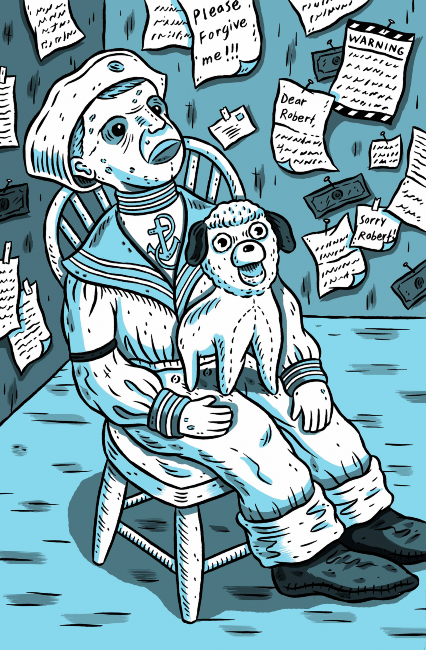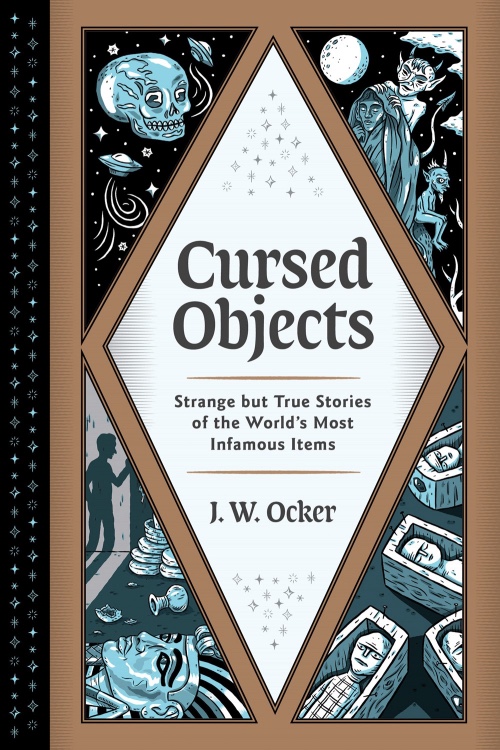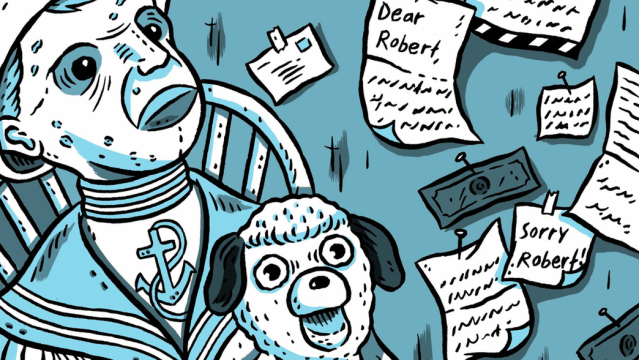Sometimes a doll is just a doll. But sometimes, it’s a doll with a history so creepy and a general aura so unsettling that it’s elevated into a rare pantheon of notoriety. J.W. Ocker investigates stories like these — and many more! — in his new book Cursed Objects: Strange but True Stories of the World’s Most Infamous Items.
Gizmodo has both the full story of Robert the Doll from Cursed Objects and an exclusive interview with Ocker chatting all about his book, which is out today. Read on… if you dare!
Robert the Doll
Place of Origin: Germany
Date Acquired: Early 1900s
Height: 40 Inches
Notable Owner: Robert Eugene Otto
Current Location: Fort East Martello Museum, Key West, Florida

Every artist wants to achieve immortality. And Key West–based painter Robert Eugene Otto was more successful at it than most — except he doesn’t live on through his art. His posthumous fame is the result of his cursed doll.
With dolls, there’s often a thin line between cursed and haunted. Dolls personify curses a little bit more than other objects, and when a cursed object can stare back at you, it’s a thousand times spookier. It may even make the curse rumours easier to believe. And that’s the case with Robert the Doll.
Unlike most cursed and haunted dolls, Robert is one of a kind. It’s about forty inches tall. It’s stuffed with wood slivers called wood-wool, or excelsior, and dressed in an old sailor’s uniform. Its eyes are black beads and its face is pockmarked with age, its features seemingly half formed, its mouth a lipless pucker. It holds a stuffed lion under one arm and sits in a rocking chair. Nothing I’m telling you here is making it any less creepy, I know.
The doll looked different, though, when a young Robert Eugene Otto was given it back in the early 1900s. Its face was originally painted like a clown’s face. That sailor suit? Otto’s own from when he was very young. Robert and Otto even share the same first name because Otto named the doll after himself. He went by Gene, however.
How Otto came to own Robert is not entirely clear. The story often goes that a housemaid gave it to him. She was either from the Bahamas or Jamaica, giving the story some island voodoo flair. Another version is that the doll was specially made for Otto and was even modelled on him. A third story has it that Otto’s grandfather picked it up on a trip to Germany. This version, although the most prosaic, seems the most likely because the doll was indeed made in Germany.
Robert the Doll was created by the Steiff Company, a German-based toy maker that invented the teddy bear. In one version of the story, Robert was never meant to be a toy. Never meant for a child’s love. Instead, it was a one-of-a-kind doll specially made for a window display. Whether this is true or not, he’s certainly one-of-a-kind now, more than a century after his creation.
Regardless of how the oversized doll came to Otto, the boy loved it. He dragged it with him everywhere. He talked to it at night and gave it a voice to talk back to him. He blamed it for mishaps. All innocent things kids do all the time but which take on a shade of the sinister considering how the story of Robert the Doll develops.
Little Gene held on to Robert the Doll even after he wasn’t Little Gene anymore. It wasn’t hard, because he also held on to his childhood home at 534 Eaton Street in Key West, Florida. His parents bought the house in 1898 and Otto lived there for most of his life, including the last forty years of it, along with his wife, pianist Annette Parker. Robert the Doll lived out that phase of his life in a turret in the house. Otto couldn’t bear to get rid of him. He was like a reverse Dorian Grey painting up there, keeping his youthful dollness while his owner aged and grayed.
Otto died in 1974, and his wife died two years later. That’s when the doll started getting spooky. People who lived in the house afterward would hear tiny running footsteps. They would hear a child’s giggling. They swore the doll’s expression changed. Eventually, one of the house’s subsequent owners, Myrtle Reuter, got rid of Robert, banishing him to the Fort East Martello Museum in 1994. Meanwhile, the Otto home was renamed Artist House and is now a bed-and-breakfast that plays up its Victorian charm and adjacency to Old Town Key West.
The Fort East Martello Museum is located at 3501 South Roosevelt Boulevard in Key West. It’s a Civil War era brick fort dating to 1862. It often features exhibits related to the history of the fort and that of the Key West area. It does some art shows. For a while the building itself was the most notable thing about the museum. Until it got Robert the Doll. Suddenly, Fort East Martello became a lot more interesting than the dozens of other historical forts that dot the East Coast.
Robert sits in a glass case in the middle of one of the rooms of the fort — a far cry from a child’s bedroom. Maybe that’s why it plays shenanigans on all the gawkers. Cameras malfunction. People see its head move or its face change expressions. Exactly what you expect a doll under glass to do. Robert exhibits all the telltale signs of a possessed or haunted object, and some people have wondered if the spirit of Otto himself is nestled deep in the doll’s stuffing. But the most convincing evidence that the doll is cursed are the letters that come to the museum every single day for Robert.
They’re not fan mail. They’re apologies. Entreaties. Each letter represents a person looking to solve the misfortunes that began after they visited the doll and mocked it or photographed it without asking permission first. According to the letters, people have experienced flat tires upon leaving the museum. Some have suffered back aches, torn rotator cuffs, and fallen down stairs. Robert has been blamed for cancelled weddings, lost luggage, lost jobs, lost homes. Near-death experiences. Bankruptcy. The death of pets. Pretty much every bad thing under the Florida sun.
If you want the Robert experience without any of the risk, you can buy a one-third-scale replica of the doll in the museum gift shop. I have one. It’s cuter at this smaller size. Less strange. Not at all creepy. Well, a little creepy. It usually sits on a shelf in my study, but I promoted it to my desk while I wrote this entry. He seemed to like the attention.
Excerpted from Cursed Objects by J. W. Ocker. Reprinted with permission from Quirk Books.
Cheryl Eddy, Gizmodo: In the book’s introduction you kind of break down how you classified a “cursed” object as opposed to a “haunted” object. Why did you decide to do that, and was that something that guided your approach from the start?
J.W. Ocker: It really did. If I’d have included “haunted” as part of my definition, well — there’s like a million famous haunted things, and it really seemed like those were [already] really, really covered by a lot of books and internet sites. But it seemed to me, and also to my editor, that nobody’s really done a lot with cursed objects. If you look online, there’s a lot of top 10 lists, but there’s no real compendium of all the most famous cursed objects. So some of it was practical; we didn’t have the space to do every haunted thing on the planet. But also it’s because cursed objects just haven’t been given their due in the paranormal stories.
[referenced id=”949275″ url=”https://gizmodo.com.au/2016/04/7-terrifying-cursed-objects-that-actually-exist/” thumb=”https://gizmodo.com.au/wp-content/uploads/2014/04/09/bhp1yar87omlyur2c1qx-300×191.jpg” title=”7 Terrifying Cursed Objects That Actually Exist” excerpt=”We recently told you about the many cursed jewels of the world, but you don’t have to have a shiny rock to have your life destroyed by an otherworldly evil. Plenty of items have terrible curses on them, which can hurt, harass or outright murder people. Here are seven items…”]
Gizmodo: You have a podcast and blog called Odd Things I’ve Seen, so it’s safe to say you have a wide-ranging interest in the unusual. What drew you to this subject in the first place?
Ocker: The genres of books I read mostly are science fiction and horror, and I’m always looking for something that kind of sticks out from the static of everyday life, you know? You could go into a building, let’s say it’s a regular school building. It’s the most boring thing in the world. But if that school building has a weird story behind it, either it’s haunted or there’s some kind of legend around it, that makes that building instantly interesting. It’s a storytelling device. The weird has always drawn me in, whether it’s paranormal weirdness, or natural weirdness, or historical weirdness…anything that isn’t mundane, normal stuff. So all my travelogues are [based] around me looking for weird stuff, [and also] my podcast and my blog. And there’s tons of it out there — there’s a lot of weird stuff to see!
Gizmodo: The book has a humorous tone running throughout it — would you say that’s your way of bringing a sceptical perspective to these stories?
Ocker: I fall into this really bad position when I write about the paranormal, and the weird, and the strange, because I’m not a believer. Not for any good reason, I just have never had an experience. So I’m not a believer, but I love the stories. I love a good ghost story. I love a good cursed object story. I love ‘em to death and I want to tell them myself. But when I’m dealing with something where there’s a very obvious alternative explanation, or — you know, when you start investigating a lot of these stories, a lot of them are the same. I just feel dishonest to not kind of bring that out as well.
And the humour is just, at the end of the day you just have to step back when you’re writing about a cursed tomb, or a cursed statue…it’s hard to not step away and realise, “I’m writing about a statue that if somebody walks through its shadow, it’ll harm them.” So it’s a weird thing to write about! The humour is probably also a defence mechanism as well, but it’s more out of wonder and joy for these things than it is for complete scepticism. I decided I’d never be in the mindset where I’d be scaring myself, that’s just not what I can do to myself, so I try to find the wonder in it, and that’s what the humour comes out of.

Gizmodo: What was your research process like, and how hard was it to separate fact from legend? Also, did you go visit many of the objects in person? You mention in the book that you have a miniature version of Robert the Doll so I know you saw that one…
Ocker: The first round of the research was actually finding what was out there. That was really hard! Like I said, you can find [similar] top 10 lists [of cursed objects] on a lot of websites, but digging deep and finding stuff — either pretty well known or obscure — that at least had a legend around it, that was the hardest part, just finding those 50 that are in the book. And after that it was just lots of digging, lots of internet research, buying books, going through research archives. There isn’t a lot of information about these things out there, so finding the real story is hard, and finding the curse story — which isn’t less real, it’s just a different side of the story — it was hard. It was probably one of the harder research projects I’ve done, as far as that goes.
Going to visit them, though, was a lot of fun. I’ve probably been to about 50 per cent of what’s in the book. Obviously, some of it is lost history and some of them are really far away from me, so I couldn’t visit those.
Gizmodo: The book opens with some of the things you might expect when you hear “cursed object,” like the Hope Diamond and the items in King Tut’s tomb. But it also covers far more contemporary interpretations of what a cursed object can be, like a chain email for instance. Why was it important for you to incorporate more recent history that way?
Ocker: To me it’s because of this transition from the physical to the digital that we’ve been going through as a culture. We think of things that are virtual sometimes as not real — like a Zoom meeting is not a “real” meeting. But the truth is, they’re just as real as any other meeting. The avatar upgrades and the level unlocks that my kids buy in games — they’re just code, but they’re objects. I mean, you could say, “A wardrobe is just wood,” at the end of the day, but something being “just code” does not make it less of a thing. And if it’s a thing, if it’s an object, then it should be able to be cursed.
So yeah, we all think of dusty dolls in the attic as something that can be cursed, but what if your pop-up window is cursed? That was really fascinating to me, and the fact that there are legends around that? The internet’s been around for, what, 30 years now, and we already have cursed objects in our lore now from the internet. That speaks to some kind of basic human thing that I don’t think I ever unravelled, some basic human need for things to be cursed, or at least to have that outlet to call things cursed. So the idea that a digital object is as real as a human object was really intriguing to me.
Gizmodo: As you learn while reading it, the book itself is cursed (if it’s stolen), so everyone who owns it will in fact own a potentially cursed object. But you also bought a cursed object off eBay, as detailed in the book. What was that like?
Ocker: Ah, that was great. This project could have been more of a straightforward encyclopaedia of cursed objects, but that’s not really my style of writing. I really have to be involved for me to be interested in the project. So when I started this book, I decided I had to be personally involved with a cursed object somehow. Fortunately, eBay is full of cursed objects — and I wanted to do it, I wanted to buy one, bring it home, keep it at my house, and see what would happen. It was honestly a lot of fun. There was a little bit of trepidation — I’m not a believer, but there was still a little bit of “Oh man, am I taking this project too far?” It gave me a little bit of a thrill. Writing a book is kind of staring at a screen for hours on end, kind of not interesting. But doing it in a way that involved me with a cursed object made it interesting, and that thing is sitting on a shelf behind my shoulder the entire time.
Gizmodo: You mention in the afterword that you hoped your interest in curses wouldn’t lead to some ironic bad luck. Are you still worried about that or have you been able to put that aside?
Ocker: So far I haven’t put it aside. I think if I can put a few years behind me and the Cursed Objects book, then I’m in the clear [laughs]. But right now, I think I’m still in that danger zone where if I died weirdly, right there in the obituary is “author of Cursed Objects book died from a cursed object.”
Cursed Objects: Strange but True Stories of the World’s Most Infamous Items by J.W. Ocker is out today from Quirk Books; you can order a copy here.
